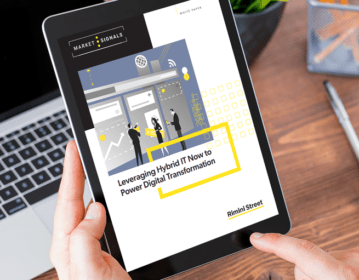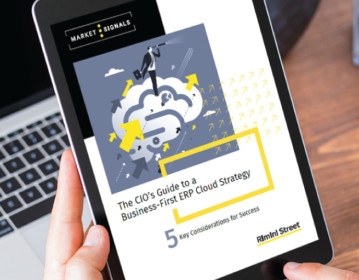
Implement hybrid IT instead and invest the savings in transformation.
An October 2020 Diginomica article, “Don’t be a sheep – challenge the call to re-platform ERP” from author Brian Sommer, contains some pragmatic advice for CIOs feeling the pressure of moving ERP to the cloud.
It’s not necessary to replace or re-platform important but non-differentiating “back-office” applications, such as moving ERP to the cloud, if there is no business case for doing so.
Although ERP vendors are heavily pushing their new products, moving ERP to the cloud or rip-and-replacing ERP is not a game-changer. Typically, it’s the vendors who benefit from moving core ERP functionality to cloud ERP or another product, or upgrading these mature systems.
“‘Package-ectomies,’ where you swap out one application for another with materially similar functionality, are rarely advantageous,” states Sommer in the article. Functions such as posting journal entries aren’t typically strategic to the business. Unless there is a really broken ERP system in use, there is likely no strategic value for the business in moving ERP to the cloud or swapping the core to a new vendor or new product line, cloud or noncloud. The vendor, however, benefits by having one less customer to support on an older release and, in the case of an upgrade to the same vendor’s newer product, one more customer in the installed base tally for its new product.
“Vendors want to see … upgrades happen as supporting those older solutions can be expensive,” he offers. Let’s be clear, vendors want this because it is usually expensive for them to keep the staff and expertise on hand to support the older releases. “… the economics for customers are pitiful,” Sommer posits. Customers still pay maintenance (typically a large portion of their IT budget) for new products after a swap-out. It won’t necessarily be less expensive for customers to upgrade, especially once switching costs (e.g. implementation, re-customization, integration, and training) are factored in.
“‘Package-ectomies’…are rarely advantageous.”
There is no need for moving ERP to the cloud as SaaS unless there is a good business case for it.
“Few vertical solutions possess rich IoT and other advanced technology to support, out of the box, Factories of the Future functionality,” says Sommer. This speaks to more than just a functional parity question for compliance, industry-specific, or unique requirements. The key here is that until businesses truly transform the way that work gets done and require systems that can support said work, there is little “new” that vertical solutions can offer other than potential. Sommer avers: “Vendors and vendor marketers often lack real business transformation stories.” — likely because they are at the tip of the iceberg on the next generation of technology-enabled business transformation.

As the article offers: “…a customer will spend a lot of money now and an unknown amount later for an unspecified value delivery.” The requirements of transformed businesses haven’t
been defined yet, so vendors cannot incorporate necessary functionality into their products. Over a period of several years, watch for an iterative evolution to reach a point where
platforms and products can offer out-of-the-box solutions for “the new norm” in business. In the meantime, platforms and technologies will be put in place and experimented on, then new business processes will be born out of the new realm of possibilities as business leaders come to understand what’s possible. This will create functional requirements that the vendors can work with to deliver prepackaged capability where it makes sense. The jury is still out on how the next generation of enterprise software will look.
“Some IT shops and systems integrators are promoting the first step [re-platforming] aggressively. These projects are pitched as necessary, critical first steps to a new digital future,” writes Sommer. Yet these high-cost, lower-value initiatives don’t yield perceivable business improvement. Many are doomed to fail simply because of the lack of visible change. Others will fail due to a lack of futuristic thinkers (business leaders and/or engineers) to use the platform to create the transformed business model.
Leverage a hybrid IT model in order to focus budget and resources on systems of engagement that support the business strategy.
Sommer offers: “The first question CIOs should be asking is: ‘Can we ring-fence the old ERP and do our transformative initiatives with new/non-ERP technology?’” This is key. Shrink the scope of what is in the definition of core ERP. Nurture and maintain it. Don’t spend a lot of time and money changing it to best manage the overall cost of Oracle ERP. Let it run like the well-oiled machine it is. “New solutions should be focused on solving today’s (and tomorrow’s) problems not yesteryear’s,” he further states. Absolutely, build a hybrid IT environment that enables investment around the edges where there can be strategic value to the business. Use this opportunity to rethink how the business operates and invest in new ways of enabling that. You will still buy and sell, create receivables, and pay for things, so leave ERP alone, skip the move to cloud ERP, and let your ERP process those kinds of transactions as it was designed to.
“[T]here’s an opportunity cost associated with these re-platforming projects,” Sommer suggests. ERP switching costs can be quite high. These funds, resources, and time could be better spent on hybrid IT initiatives that further business objectives, fuel growth, or enable transformation.
“Vendors will shove you around unless you stand up for yourself.”
Put the business in the driver’s seat of your application roadmap.
“Vendors will shove you around unless you stand up for yourself. Drop-dead dates are a type of ultimatum,” the author ultimately avows. The experience is that software licensees are facing this pressure almost all of the time. Disrupting the software industry more than a decade ago by creating the independent enterprise software support category, Rimini Street has had a front-row seat to this dynamic world inside IT ever since.
Licensees need to take back control of their application roadmaps and relieve vendor pressure for moving ERP to the cloud or for re-platforming. Independent, third-party support creates a win/win — lower maintenance costs and freed-up funds, resources, and time to invest where the business needs to go.





